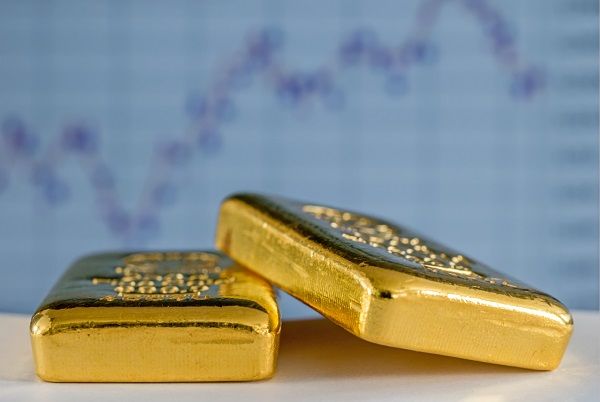Earth’s Riches May Stay Locked Away Forever
Posted on — 1 CommentAs the old saying goes, “water, water, everywhere, but not a drop to drink.” This sentiment perfectly summarizes the question of scarcity in gold mining. Many have asked, “how much gold is there left to be mined.” The short answer: much more than you think. The long answer, however, is more complicated. Let’s look at why the Earth’s untold riches may stay locked away forever.

If melted into a single cube, all the mined gold would fit into an Olympic-sized swimming pool. Business Insider cites Goldman Sachs analyst Eugene King as calculating that there are “20 years of known mineable reserves of gold.” It stands to reason, however, that each successive year of theses 20 will present increasing difficulty to those seeking to extract the reserves. It’s likely that much more than 20 years worth of gold exists on Earth. However, much is impossible to ever capture. Millions of tiny gold particles are in the ocean and sitting on the floor of the sea.
Today, it’s unclear how much longer production can continue. While technology continues to offer solutions of growing sophistication, the cost of implementation can quickly offset the value of the find. Simply put: diminishing gold production is about more than scarcity.
Here’s why: the time between deposit discovery and production is growing. The average time needed to yield gold from a source is now 20 years. By comparison, this figure in the year 2000 was approximately ten years. With a longer time to production comes greater costs which diminish the prospects of many finds. In recent years new mines have yielded less. New mines are making less of a contribution to total, global production.
In fact, as recently as 2014 Chuck Jeannes, chief executive of Goldcorp, remarked, “whether it is this year or next year, I don’t think we will ever see the gold production reach these levels again,” as reported by The Wall Street Journal. “There are just not that many new mines being found and developed,” he concluded. Statements like this have prompted some to claim that we’ve hit “peak gold,” a new phase where all remaining gold production will require significantly greater labor than previously.
If true, this prediction bodes well for gold investors. A look at history suggests those claiming that we’ve hit peak gold might be right. Consider that in 1995 we sourced 22 gold deposits each containing at least two million ounces of gold. In 2010, only six discoveries occurred, and in 2011 there was just one. The trend is clear.
This diminishing story has altered the strategies of key players in the industry. That is, some miners are focusing their efforts and finances on acquiring other firms that already have ownership of newer mines. It’s become easier to buy a deposit rather than source it yourself.
In the meantime, many geologists are divided on the issue. Some believe we have, in fact, reached peak gold. Others claim it’s too difficult to adequately predict the remaining deposits and their accessibility. However, one fact is clear; we’re finding less gold each year.
This truth may be the reason countries like China have aggressively built up their reserves in recent years. As a global currency with diminishing availability, many are poised to win big in the long-term.
4 Reasons Gold Prices Will Keep Rising In 2018
Posted on — Leave a commentGold just turned out its best annual return – a whopping 12% gain – since 2010. Can gold do it again in 2018? You bet.
Here’s 4 reasons that gold can continue to rally in the coming year.

- Stock Market Is Overvalued and the Bull Cycle is Old
When stocks are going up, it’s easy to forget that the market does go down. There’s bull market cycles (when stocks are rising) and bear market cycles (when stocks are falling). The current bull market phase began in March 2009 and will soon hit its 9th birthday. For bull markets – that’s old.
In 2018 it would not be a surprise to see a
- Pullback in Stocks (5% dip from recent high),
- or a Correction (a 10% sell-off from the high)
- or a Bear Market (declines of 20% or more).
Gold is an excellent portfolio diversifier and has virtually no correlation to the stock market. In fact, historically, down cycles in the stock market have seen significant gains in gold prices.
- The U.S. Deficit Is Getting Worse (Not Better)
While the deficit is not something you probably think about, well maybe not even ever – it is an issue for financial markets. There’s that old saying – and at some point the Piper will demand payment. The U.S. National Debt recently topped an eye-popping $20.6 trillion and rising. Former Federal Reserve Chair Janet Yellen recently warned that the $20 trillion national debt “should keep people awake at night.”
The recent Tax Bill passed by Congress slashed taxes by $1.5 trillion on corporations and individual Americans. Going forward, that is likely to make the deficit worse, not better.
“Solving the nation’s fiscal challenges was difficult before the tax bill was enacted, and it has only gotten even more challenging. Returning to historic averages of revenue will not be sufficient, given that historic levels of revenue have led to our current fiscal problems and will be insufficient to cover the costs of an aging population,” says the non-partisan Committee for a Responsible Federal Budget.
The U.S. dollar is falling in value and the nation’s debt load is rising. Gold becomes even more valuable as that scenario continues to unfold.
Gold is a currency without a nation – and that means there are no “debts” attached to the physical metal (unlike the $20.6 trillion debt attached to paper money).
- The Rise Of Bitcoin
One of the biggest investment stories of 2017 was the massive price increase in cryptocurrency bitcoin. There are similarities between bitcoin and gold. A key factor that has attracted interest in bitcoin is that it is a form of money outside the control of any authority or government in the world. Gold, of course, is too. “Bitcoin is paving the way for the reintroduction of gold as global money,” said fund manager, Ned Naylor-Leyland in a recent Bloomberg interview. Read more on why the pros and cons of investing in bitcoin here (Investing in Bitcoin, part 1 and Investing in Bitcoin, part 2). The appetite for bitcoin as an investment is also fueling fresh demand for physical gold.
- The Return of Inflation
Inflation, what’s that? According to official economic data, inflation has been low, extremely low for years now. Barron’s just published a new piece on inflation and warned: “We expect to see inflation go up in 2018 across developed markets relative to where it is today with the United States leading the way.”
Barron’s pointed to repricing of cell phone plans, higher car prices, the recent Congressional tax cut package, and a weaker U.S. dollar as factors that are pushing the overall level of prices higher.
Gold is a traditional inflation hedge and once higher official government readings of inflation emerge, investors will stampede into precious metals in order to hedge their assets.
Protect Your Assets with Physical Gold
Rare coins are an even better hedge against inflation than gold. If you want to lock in an insurance policy for your assets now, diversifying into rare coins offers the potential for out-sized gains. Download an exclusive report from researchers at Penn State University to learn more. The results suggest that over the longer run including rare U.S. coins within an existing portfolio could improve investment performance. Don’t delay, economists warn the cycle is at a tipping point and once the inflation numbers come out higher, gold prices will surge – probably significantly.
The Three People Who Influence Gold Prices
Posted on — Leave a commentLike all investments, the price of gold is dictated by the markets. However, there are a few key influencers who wield significant influence over the price of gold. Their actions, in aggregate, do not directly alter the price per ounce. Rather, their broad directives serve to rally or squelch interest in the commodity thereby increasing or decreasing the price appreciation over the long-run. Here, we look at three people who may exert their influence over gold throughout 2018.

Jerome Powell
Set to take over in his new role as the Chairman of the Federal Reserve next month, Powell will be the key player in the interest rate changes expected in 2018. Today, it’s still unclear to what extent he’ll raise rates. Some have predicted a dovish approach characterized by just one increase this year. Others expect at least two or three. These rate changes will undoubtedly serve as a key driver of gold prices. In many periods, though not all, there has been a negative correlation between interest rate changes and the price of gold. A more aggressive rate increase policy from Powell may put downward pressure on prices. For the moment, Powell appears ready to make at least his first increase soon. “I think the case for raising interest rates at our next meeting is coming together,” he remarked in late November of 2017.
Kim Jong Un
Verbal tirades between the North Korean leader and President Trump show no signs of slowing and have, in recent months, escalated at a frightening pace. “I would attribute some of the rise in the price of gold to the feeling of uncertainty surrounding that [North Korean-U.S.] dialogue,” explained the Director of Financial Services Policy at the American Action Forum as reported by The Washington Post. Other experts have noted at least a mild correlation between the recent spate of missile launches and the rising price of gold. In fact, CNBC reported that gold jumped more than one percent in one day in November of 2017 reacting to heightened geopolitical fears. The risk of a nuclear threat emanating from an unstable government has reinvigorated interest in the “safe haven” appeal of gold. As Kim Jong Un’s intentions come into focus this year we’ll know more about how renewed interest in gold will unfold.
Xi Jinping
Chinese President Xi Jinping is putting the full weight of his country’s resources behind what he calls “The Belt and Road Initiative.” Essentially, the development plan is designed to boost trade and economic growth across Asia. The largest projects within the plan will be infrastructure related with some estimates that Jinping will “pump $150bn into such projects each year,” according to the Guardian. How does this tie to gold? Miners are expected to use this investing to ramp up exploration and production. The CEO of China National Gold Group Corp, explained last year that he would “intensify exploration and capital allocation in Belt and Road countries.” This move has serious implications given that China is the leading gold producer in the world yielding 455 metric tonnes in 2016 alone.
Gold investors should keep a close eye on these three key players. Their actions, in total, can make significant impacts on gold pricing.
Three Ingredients for a Gold Rally in 2018
Posted on — Leave a commentThere’s no denying it, equities had a stellar year, Bitcoin even more so. However, as 2018 draws near major investment firms are making their predictions about the next twelve months and some see a climate forming that could be good for gold investors. Here, we take a look at three trends that may boot the commodity offering some a golden opportunity.

Weak Dollar, Strong Gold
The recent performance of the dollar is in stark contrast to the boom times of the equities market. The dollar has seen its largest annual loss in value since 2003. For 2017 the ICE U.S. Dollar Index which measure the value of the dollar against six other currencies fell 9.8%. Why does this matter to gold investors? Historically, there is an inverse relationship between the U.S. dollar and gold. This relationship stems from the fact that while the U.S. holds more gold than any other country, we do so by importing the metal. These imports, priced in USD, will become more expensive as the dollar falls. Moreover, those who own U.S., debt, namely foreign countries, become less confident in our financial standing when our currency falters. As a result, gold, a safe haven asset, rises.
Geopolitical Concerns Rise and Gold Follows
While other global economies are experiencing the euphoria seen in U.S. markets there are reasons, some argue, to exercise caution. One recent example comes from Germany where Chancellor Angela Merkel’s latest attempts to form a government failed. Meanwhile, threatening overtones from North Korea continue to escalate sendinging trepidations throughout the U.S. and countries that neighbor Kim Jong-un’s regime. In recent months we’ve seen examples of the correlation between rising fears of a nuclear engagement with North Korea and the price of gold. In early October gold prices climbed when President Trump increased his resolve to retaliate against Kim Jong-un. Meanwhile angst in Spain is on the rise as a possible Catalonia succession looms and Iran has refused to revise their nuclear deal with six world powers.
History Repeats Itself
It seems that even commodities like gold want to start a new year on the right foot. Case in point: In both December of 2015 and 2016 gold bottomed out in value. This drop was followed by a rally in January of 2015 and 2016 respectively. “Given the fact that gold’s previous lows were formed in the past two Decembers, the yellow metal could score a hat-trick if it maintains its rally in early 2018,” remarked one analyst at Forex.com. Other analysts at Casey Research compiled nearly 40 years of research dating from 1975 to 2013 showing that gold’s second strongest period based on monthly average gain is in fact January notching a little more than a return of 1.5% (September is the strongest).
With these three factors in mind gold investors might just be setting themselves up for success in a market that promises to serve more surprises throughout 2018. Over the long-term, gold offers balance to a diversified portfolio by giving investors an opportunity to profit from key market conditions like those ahead of us.
Five Things That Moved The Price of Gold In 2017
Posted on — Leave a commentThe price of an ounce of gold surged over $125 an ounce since the start of 2017, for a roughly 9% gain. That’s an impressive move. If you bought an ounce of gold at the beginning of the year you’ve baked in a nice return.

What are a few factors that moved the price of gold this year? Let’s take a look.
- Threat of War with North Korea
Tensions have never been higher with the rogue nuclear-armed nation of North Korea.
The country fired 23 missile tests since February.
“Most Americans don’t realize how close we are to war,” said Illinois Senator Tammy Duckworth.
Gold is a traditional safe-haven and investors turned to the metal as various Twitter exchanges between President Trump and North Korean Supreme leader Kim Jong-un ratcheted higher throughout the year. The leaders of the two countries exchanged threats and taunts, including “dotard” and “Little Rocket Man.”
“The key problem for the United States is the likely possibility that North Korea has the missiles to deliver nuclear bombs to South Korea and Japan. If one of these weapons were to reach its target, an entire city would be annihilated,” noted a New York Times article December 6.
- Weakness in the U.S. Dollar
The U.S. dollar index fell 12% in 2017. A weak dollar is good for gold, but a signal of underlying weakness in the U.S. economic, political and perhaps even military might.
A weaker dollar makes gold cheaper for foreign buyers, who used the lower prices to snap up the precious metal at bargain prices.
However, the weaker U.S. dollar trend is a negative sign regarding international views of our country’s economic, political and fiscal policies. The level of a nation’s currency is a type of “grade” on how the country is viewed versus other countries around the globe to international money managers. Gold is a currency with a nation and without any of the fiscal obligations (or debt) that come with various governments around the globe.
- Stock Market Hit New All-Time Highs
The aging bull cycle in U.S. stocks hit its eighth anniversary in 2017. By traditional valuations, the stock market is overpriced and overvalued. Just how overvalued is the U.S. stock market right now?
“Shiller’s cyclically-adjusted price/earnings (CAPE) ratio for the S&P 500 has climbed to around 32. The last time it rose to such a high level was in the late 1990s, shortly before equity prices in the US plunged,” wrote economists at Capital Economics on December 18.
The gold market climbed over 9% this year, alongside an exuberant stock market. Investors turned to gold this year, as a way to take some risk off the table, with equity prices at sky-high levels.
“We seem to be living in the riskiest moment of our lives, and yet the stock market seems to be napping: I admit to not understanding it.” — Richard Thaler, winner of the 2017 Nobel Prize in Economics
- Federal Reserve Rate Hikes
The Federal Reserve hiked interest rates three times in 2017, in March, June and December. Yet gold prices continued to climb despite the Fed’s move. Why? Because official interest rates remain at historically and abnormally low levels, with the Fed funds rate at 1.50% to end the year. Interest bearing accounts offer little return and risk levels in the stock market are at the highest level in over a decade. Investors continue to turn to gold as a hedge against a depreciating U.S. dollar and a hedge against stock market declines.
- Major Tax Package Overhaul
In late December President Trump signed into law a $1.5 trillion tax overhaul package. The stock market climbed as corporations receive a massive tax break, which could help the Price/Earnings ratio of publicly traded companies. Gold also climbed higher in in the second half of December. Many economists believe that this tax package will ultimately spike the U.S. deficit – already at $20 trillion even higher. That’s gold bullish.
The New Year is just around the corner. If you are making resolutions for 2018, purchasing gold right now could be one of the best ways to kick off the New Year right. Protect your assets. Hedge your risk against an aging, overvalued stock market. Make 2018 your best financial year ever.
How Much Cash Do You Have On Hand?
Posted on — Leave a commentCash is king. Right? Yes, and no.

Holding at least six months of living expenses in an emergency fund is a smart financial move. Life happens. An unexpected trip to the emergency room. Car repairs. A job loss. These are all good reasons to hold about six months of expenses in cash.
Beyond that, however, you may be missing out.
- Economists call this “Opportunity Cost,” or the loss of a potential gain you might have had if you made a different choice.
Holding large amounts of cash, might give you some psychological comfort in the present. But, it doesn’t do “Future You” any favors. Why not? Over time, inflation erodes the purchasing power of your cash.
- Inflation occurs when the price of the same good or services costs more than it did a year ago, five years ago or twenty years ago.
See how prices rise:
- The average cost of a new house climbed from $19,300 in 1963 to more than $150,000 in 2016.
- The consumer price index is about 500 percent higher in 2016 that it was 40 years ago. That means that the average item in the grocery store costs 5 times more than it did in the early 1970s.
- From 1990 to 2013 the cost of an average car doubled from $16,950 to $31,352.
- In 1990 a loaf of bread cost 70 cents and in 2013 that same loaf cost $1.98.
How Much Cash Is Too Much?
Americans are holding about 58% of their investable assets in cash, according to a Blackrock investor survey. When you want to protect your future, that percentage is too high.
“Holding cash means you are actually losing money every year as inflation drains away the purchasing power of your cash.”
About six months of living expenses in cash is important. Beyond that, you are facing serious opportunity cost.
Chasing Stocks Is Not the Answer
Many Americans are understandably hesitant to put fresh funds into the stock market at its current overvalued, record-high levels. In fact, the current rally in stocks has left many Americans exposed to more risk than they may realize.
What’s Your Number?
If you intended to have a 40% allocation to stocks, 20% allocation to bonds, 25% allocation to cash and 15% allocation to tangible assets like physical gold and silver, you are likely far overstretched in the stock category right now.
Put Your Cash to Work
Review your statements. If the latest run up in stocks has pushed you beyond your intended stock allocation level, book some profits. Many Blanchard clients are using the new all-time highs as a smart time to take some money off the table in the stock market and plough those assets into tangible assets like gold.
Protect Your Assets Now
One of the most brilliant fund managers of our era – Bill Gross, portfolio manager at Janus – warned investors to “be careful in 2018.”
The current abnormally low level of Treasury rates leaves money managers and individual investors few options to “hedge their risk.”
“Should a crisis arise because of policy mistakes, geopolitical crises, or other currently unforeseen risks, the ability to protect principal will be impaired relative to history,” Gross said in his most recent letter to investors.
Gold Is an Excellent Portfolio Diversifier
If you are sitting on more cash that you need, put your cash to work. Buy gold and silver now to protect your future purchasing power and to hedge against a downtown in the stock market.
Gold has generated strong returns in 2017 – and that is despite a strong stock market and rising interest rate environment. Now is not the time to chase returns in an aging and overvalued stock market. The case for gold has never been stronger.
Put your cash to work. Tomorrow, it will be worth less than it is today. In five years, that cash will be worth even less.
The Three Ways Gold is Driving Clean Technologies
Posted on — Leave a commentWhen we think of clean tech we often envision natural elements like water powering a generator, or sunlight charging solar cells. However, another natural element, gold, is also driving changes that allow industries to thrive with less of an impact on the environment. Here, we look at three examples where gold is playing a pivotal role in creating a greener future according to the World Gold Council.

Mercury-Free Manufacturing
Today, the third most widely produced synthetic polymer is poly vinyl chloride (PVC) which is used to make pipes and insulation for electrical cables. However, making PVC is a labor-intensive process which first requires the manufacturing of vinyl chloride monomer. Doing so requires a catalyst. The problem: the most commonly used process relies on a mercury-based catalyst. The prevalence of PVC in construction and plumbing today means mercury is needed in high quantities. This demand presents environmental problems given the problems mercury causes wildlife like fish. Moreover, mercury is toxic to the brain and spinal cord making its disposal particularly dangerous. However, recently, gold catalyst processes have emerged offering a solution to this problem. As the World Gold Council reports, “This breakthrough provides an opportunity for VCM producers to remove a highly toxic material from their process in a cost-effective manner. Depending on uptake, this application could generate total demand in the region of 1-5 tonnes of gold.”
Clean Fuel Cells
Gold is also helping bolster the adoption of electricity-producing fuel cells. This innovation limits toxins in the environment because the only byproduct is water. Like the manufacturing of PVC, a catalyst is needed. However, in this case a special catalyst is required, one that can function at low temperatures. Gold is the solution. We’re likely to see a significant ramping up in the manufacturing of these cells as more industries and countries take ownership of the future of the planet. The result could be a further increase in demand for gold.
More Efficient Solar Power
In short: gold offers improved efficiency in solar panels. For solar cells to effectively harness the sun’s power they require gold nanoparticles. Why? Traditional designs require a web of wiring which sits on top of the solar cell. These wires, however, can block up to 10% of the sun’s light. Researchers have discovered a way to redesign the panels without the wires. Instead, scientist can place a thin film of gold on a silicone sheet. This film allows more light to penetrate and some estimate near-term designs to offer up to a 20% boost in efficiency. Therefore, solar-powered technologies will likely expand their reliance on gold. Moreover, in newer designs gold is also needed for the electrodes.
These three emerging technologies illustrate the versatility of gold. While the element hasn’t changed we are constantly changing the way we can use it and finding new opportunities to expand its value in various industries.
Can bitcoin do any of that?
When the Bitcoin Bubble Bursts: What Will It Mean?
Posted on — Leave a commentThe price of Bitcoin has tripled over the past month. A clear “feedback” loop is underway in bitcoin price action right now.

The Media reports on the new highs, which ignites interest from mom and pop investors who want in on the opportunity. Then, it hits another new high. The Media reports on it again, which ignites another round of buying.
Some Wall Street professionals have warned this could be bubble-like activity. Maybe, maybe not. Only time will tell. That does beg that question, could a Bitcoin price retreat have a spillover impact on other financial markets or the broader economy?
Let’s look to history as a guide.
When bubbles burst in the past two decades there has been meaningful impact on the broader economy and the financial markets.
- Remember the Dot.com bubble that burst in early 2000?
- It took the S&P 500 13 years before it surpassed the 2000 high again.
- Remember the U.S. Housing Bubble that peaked in 2006?
- Housing prices in some states still have not returned to those price levels.
Bitcoin has few Links to the Actual Economy
Bitcoin is not intertwined in the real economy, or even the financial markets in any meaningful way. One major investment firmed called it “a curiosity.” If the price of bitcoin were to correct sharply lower, it won’t hurt the economy, the labor market, or the stock market. That’s the good news.
Gold Report
The price of gold fell last week, skidding to a fresh four-month low? The culprit?
Blame it on the speculators.
The “excuses” for gold selling included:
- U.S. dollar strength
- Senate approval of the U.S. tax cut package
- Stronger-than-expected U.S. labor report for November
But, at the end of the day, it was speculators pressing on the market as day traders took advantage of “shorting” opportunities.
Fed Watch
As expected, the Federal Reserve hiked interest rates at this week’s meeting on Wednesday afternoon. While the rate hike was widely expected, it could open the door to modest weakness in the gold market. The short-term gold chart outlook has weakened in the wake of the recent selling. That means there could more to go on the downside, before a “bottom” is found and long-term investors swoop in for great bargains.
What level should you be watching for? The $1,225-$1,215 per ounce area offers potential support for gold. If the price drops that far in the days ahead, long-term investors would be lucky to have the opportunity to buy at that price.
Stay tuned. Buying opportunity ahead for gold.
Investing In Bitcoin: A Special Report – Part 2
Posted on — 2 CommentsLook Before You Leap into Bitcoin
Remember the dot.com boom? Internet companies with no revenues and profits, but massively overvalued stock prices?

The current mania round Bitcoin has a similar look and feel. Are people talking about Bitcoin? You bet. Were taxi drivers and hair dressers talking about dot.com stocks? You bet. And, that did not end well.
Throughout history, markets of all kinds tend to “peak out” or post “blow-off” tops not long after the man on the street starts rushing to join the party. It is a cycle that repeats over and over again and Mom and Pop are always the one who get hurt. At tops the general public rushes in because they are attracted to rising prices. Just like Bitcoin right now. The general principles that underlie the markets don’t change and continue to drive price cycles over and over again.
We’ve already outlined 3 key reasons investors should be wary of Bitcoin 1) It has no intrinsic value. 2) It appears to be a bubble. 3) Bitcoin could simply disappear one day.
Here are 8 more points investors need to read:
4. Is Bitcoin a currency?
Let’s talk about what defines a “currency.” Since 1913 in the United States, our currency has been issued by the federal government.
The U.S. dollar and major currencies around the world are:
- Backed by the full faith and credit of that government.
- It is physical. There is paper money and there are coins that you can touch.
Bitcoin is not backed by any government. There is nothing tangible that you can ever see, touch or hold.
In fact, bitcoin is the antithesis of gold. Let’s look at some key characteristics of gold and why investors continue to turn to precious metals as a true viable method of wealth preservation and accumulation.
- Gold is a tangible asset.
- Gold is physical.
- Gold is not issued by a government, which means it is nobody’s liability (not associated with any government debt or deficit).
- It has true physical supply – you can only pull so much gold out of the earth. (Unlike a computer software program where they can change the “rules” and create more than 21 million bitcoins at any point in time).
5. Cryptocurrencies are Unknown and Unproven
Get this. There are over 1000 cryptocurrencies right now. Have you heard of:
- Litcoin
- Namecoin
- Ethereum
- Zcash
- Dash
- Ripple
- Monero
These are all part of the “altcoin” fad. Any of these cryptocurrencies could go bust at any time, leaving investors with zero. In fairness, these cryptocurrencies can explode in value as well.
6. Regulators May Pounce At Any Time
Sudden regulatory changes could emerge at any time in response to the concerns that this cryptocurrency is being used in black market transactions, money laundering and other illegal activities.
- Governments could ban the use of bitcoin at any time.
The SEC has already warned that Bitcoin is subject to regulatory risks and federal securities laws. It would not be surprising for a regulatory body to issue regulations that could completely disrupt the availability and accessibility and liquidity of bitcoin.
A Federal Reserve regulator said last week that bitcoin could pose a threat to financial stability. Regulators are just getting started. Once regulations come down, investors could be left holding a worthless piece of cyberspace.
7. Exchange Heists
There are no bank robbers with guns. But, they steal money just the same. More than 980,000 bitcoins have been stolen from exchanges, either by hackers or insiders, according to news reports. That totals more than $10 billion at current exchange rates. Few of the stolen bitcoin have ever been found.
8. The IRS are getting involved
Anyone who thinks they can avoid taxes using Bitcoin is wrong.
A federal court has demanded that Coinbase, the largest cryptocurrency exchange to hand over its customer list to the IRS. More than 14,000 customers are suspected of tax evasion.
Because Bitcoin is viewed like any other asset by the IRS, every transaction, no matter what size must be reported. Coinbase is fighting this, but they are expected to lose. The IRS is a powerful entity and will demand what its due in back taxes, penalties and fees once they obtain the customer list.
9. The Smart Money Doesn’t Invest in Bitcoin
Institutional investors are not investing in bitcoin. There may be some speculative trading in bitcoin. But, smart money investors are not buying bitcoin to buy and hold. It is a speculative market. The Wild West.
10. Bitcoin is not viable for Traditional Commerce
The intense volatility of Bitcoin prevents it from being used in commerce in any meaningful way. The wild swings in price, both higher and lower, create uncertainty when it comes to buying and selling in bitcoin.
- It fluctuates – often dramatically – on a daily basis.
In fact, in early 2017, McKinsey consulting firm said that it appears unlikely that the Federal Reserve for the U.S. Treasury will start accepting bitcoin as a form of payment anytime soon due to regulatory risks.
It is, however, being used by criminals due to its decentralized structure and ability to move money from local currencies into bitcoin, and then out of the country and finally into a different currency.
11. Bitcoin Is Not A Safe Haven
Bitcoin is no safe haven asset. It is a wildly risky and speculative investment. That compares to gold, which has proven itself over the millennia. It is real currency and a real store of value.
Consider these facts about gold:
- Gold is a physical hard asset that you can hold and touch, or put in your safe deposit box. It’s real.
- Gold is considered to be the world’s first international currency when King Croesus first minted coins back in 564 BC.
- Governments around the globe continue to buy and hold gold because of its true intrinsic value.
- Gold is rare. At the end of 2012, there were only 174,100 metric tons of stocks in existence above ground. If every single ounce of this gold were placed next to each other, the resulting cube of pure gold would only measure 20 yards in any direction, according to the World Gold Council.”
Investors who want to preserve and grow their wealth should consider a currency that has been around for over 2,000 years – has been tried and tested – a proven portfolio diversifier. From 1968 to 2016, optimal portfolio had 27-30% of its assets in gold and the rest in stocks and bonds, according to Jeffrey Christian, managing director at CPM Group.
Can you make money in bitcoin? Some will, most won’t.
Investing In Bitcoin: A Special Report – Part 1
Posted on — 4 CommentsHave you wondered if you should buy some bitcoin? If you answered yes to that question you are not alone. After all a massive media blitz has highlighted the cryptocurrency’s recent surge to a new all-time high above the $16,000 level.

Sounds like an investment you should be in on, right?
If you were lucky enough to purchase bitcoin at $1,000, congratulations!
While the tug of the “Fear of Missing Out” could be strong, remember the old Latin phrase: Caveat Emptor, which simply means “let the buyer beware” applies here. Let’s start with the basics.
What Is Bitcoin?
Bitcoin is a digital “virtual” currency developed in 2009 by the shadowy figure Satoshi Nakamoto. It is a global payment system that allows for anonymous peer-to-peer payments with no centralized authority. Bitcoin transactions take place via “blockchain technology” which is a so-called digital ledger where these transactions are publicly and chronologically recorded.
- Bitcoin is not a physical currency. It is not issued by any government and it is not legal tender.
People who use bitcoin confirm the validity of bitcoin using the publicly availably blockchain transactions on the open source digital ledger.
Where Does Bitcoin Come From?
So-called “miners” earn bitcoins who use their computers to confirm Bitcoin transactions. Every transaction is linked to other transactions to create blocks. These are linked to create the blockchain. This blockchain technology holds a record of every Bitcoin transaction that has ever taken place. As these computer operators verify transactions, they earn new Bitcoin, which is how new currency is “created.” The original computer program allows for 21 million Bitcoin to be generated.
What about Regular People?
People can buy bitcoin on exchanges, such as Coinbase and pay a fee to store Bitcoin in an online wallet.
11 Things to Consider Before You Buy Bitcoin
- What is the value of Bitcoin
People are focusing on the massive price increase, the record-setting “value.” But, what is actual the value of Bitcoin? There is none. People are buying Bitcoin on the “hope” that it will become widely accepted and widely used.
Recently, JPMorgan Chase & Co. Chief Executive Officer Jamie Dimon called bitcoin a “fraud” and he said he would fire any employee who was caught trading bitcoin for being “stupid.” However, he did admit that bitcoin was a good option for murderers and drug dealers.
2. Could Bitcoin be in a bubble phase?
People are buying it as part of a speculative buying binge. Remember the economic bubble in Dutch Tulip Bulb Mania?
In 1637, at the height of tulip mania some single tulip bulbs sold for more than 10 times the annual income of a skilled worker. Like all economic bubbles, it eventually popped. As tulip bulb prices dramatically collapsed over the course of a single week, many tulip bulb investors instantly went bankrupt.
“These bubbles tend to end in tears. And I worry about how this bubble might end,”
Billionaire hedge fund manager Ken Griffin said about bitcoin to CNBC on Nov. 27, 2017.
3. Security Risks: Any Bitcoin you might buy could simply disappear one day.
Bitcoin may be hacked. Operational glitches or malware could disrupt the peer-to-peer network. Cyberattacks can open the door to stolen private encryption keys.
This has already happened:
-
Hong-Kong based Bitfinex was hacked in August 2016. That resulted in the outright theft of $65 million in Bitcoin.
- In 2014, the Mt. Gox bitcoin exchange filed for bankruptcy and announced that 850,000 bitcoins had vanished into thin air. Simply gone.
The hackers: The bitcoin world is their world. They understand the shadowy worlds of the dark net better than anyone. If you think any bitcoin you might buy is “safe,” just remember how protected your Social Security number was by Equifax earlier this year where 145 million Americans had their most sensitive personal data stolen. Simply stolen. Bitcoin is a computerized technical system with who knows what vulnerabilities yet to be discovered.
Investors who are considering buying bitcoin need to understand the realities of what bitcoin is and isn’t. Take the time to learn the facts.
More reasons that you should be wary of Bitcoin in Part 2 of this Special Report.








